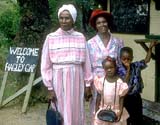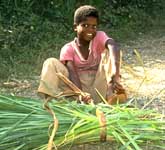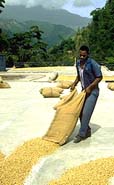| | | 
Jamaican Life
Jamaica... a beautiful, sun drenched Caribbean island, surrounded by glistening, clear, blue-green waters... where the spicy aromas of exotic fruits fill the air... where the relaxed, smiling people don't have a care in the world-"No problem mon." This is the face of Jamaica the tourist industry presents. But, it's only half the story. On this journey, we saw the duality of Jamaica--a land of overwhelming beauty, overshadowed by a history of poverty and oppression, held together by the power of community and a common will to survive. In spite of the hardship we witnessed, the great resiliency of the Jamaican people was always evident and impressed our entire group. On this journey, we saw the duality of Jamaica--a land of overwhelming beauty, overshadowed by a history of poverty and oppression, held together by the power of community and a common will to survive. In spite of the hardship we witnessed, the great resiliency of the Jamaican people was always evident and impressed our entire group.
Xamayca- "Land of Many Springs"The "easy life" that lures so many tourists to Jamaica has never existed for the native population. There are no more Arawaks, the earliest known people of Jamaica. They were all killed by the colonial Spaniards who took over the Island in the early 16th century. The island was discovered by Columbus on his second voyage in 1494. He was looking for gold to bring back to Spain, but found none. In 1510, Spanish colonists began to settle and easily enslaved the naively trusting natives. In just a few decades the Arawaks were virtually extinct, succumbing to extremely hard labor, cruel torture, and the new diseases brought by the foreigners.The Jamaicans we encountered are the descendants of slaves from Africa, brought over to supplement, and then replace, the Arawaks on the colonial plantations. Export crops included cocoa, sugar, tobacco and cotton. In 1655 the Spanish, who weren't paying much attention to Jamaica, lost the island to the British. Since then the Jamaicans' situation has improved somewhat, including the abolition of slavery in 1834 and gaining official independence in 1962. However, the long history of exploitation is still evident in the lives of the Jamaican people. Most land and business is controlled by a small group of families and corporations.School in JamaicaIn Jamaica, school is a privilege, not a right. In order to attend elementary school, all children must wear shoes and clean uniforms. For most of the kids we met in this rural area this is a hardship or impossibility. It seemed ironic that many of the local children who so enthusiastically befriended us and watched us painting would not be able to attend the Mines Basic School at all. Getting to high school in Jamaica is also difficult. All students who want to continue in school take a test in the eighth grade. If they pass, then they must pay tuition and purchase their own books. As hard as this is for these young people to accomplish, many of them cling to school as the only way out of a life of certain hardship. Getting to high school in Jamaica is also difficult. All students who want to continue in school take a test in the eighth grade. If they pass, then they must pay tuition and purchase their own books. As hard as this is for these young people to accomplish, many of them cling to school as the only way out of a life of certain hardship.
Our teens were impressed by Leighton, a Jamaican teenager they met near Mines. He is from St. Anne's, a typically poor Jamaican community within sight of the luxurious tourist resort of Ocho Rios. Leighton was the country's top high school science student in 1994. In sharp contrast to most others who are looking for a way out of the country, he has decided to attend college in Jamaica--in spite of the offer of a full scholarship from the University of Georgia, in the United States. He wants to stay to help his country.While the government's policies on education may be well intended, It is obvious that they present great obstacles to its people and help perpetuate a national problem of illiteracy.Jamaican EconomyAlthough Jamaica is rich in natural resources and products, such as bauxite, sugar cane and coffee, there is a high rate of poverty and illiteracy. Finding work of any kind is hard. Many of the residents in the communities we visited have no job. Currently only a few store owners and school teachers work in Hagley Gap. Some people work an hour away in Mavis Banks at a coffee processing plant. We visited the plant to learn about coffee production and local industry. We learned that the world's most prized coffee, which sells for over $30 per pound in the U.S, is processed entirely by hand for wages so low that the workers need overtime to feed themselves. Even so, these workers consider themselves fortunate. One of the men patching the stucco on the church told us he frequently leaves for months at a time to work construction in the U. S. in order to feed his family. We visited the plant to learn about coffee production and local industry. We learned that the world's most prized coffee, which sells for over $30 per pound in the U.S, is processed entirely by hand for wages so low that the workers need overtime to feed themselves. Even so, these workers consider themselves fortunate. One of the men patching the stucco on the church told us he frequently leaves for months at a time to work construction in the U. S. in order to feed his family.
Developing a business to guide tourists up the Blue Mountains is one idea the leaders of Hagley Gap have to generate new income. At more than 7, 000 ft. the Blue Mountain Peak is the highest point in the entire Caribbean.On our ninth day, after working all morning on our projects, we set off for an overnight hike to the Peak. It's a nine mile trek to the top up a steep, winding dirt road. Some of the locals walked the mountain every day, to get to and from school or work. While they do it because they don't have cars, we walked it for the adventure. They told us they could make it in two or three hours. We took over six, hiking well past dark, through intermittent rain to reach our lodge. Some of us were slower and needed a lift in the jeep. But for everyone it was harder than we imagined and turned out to be a memorable and important personal accomplishment. | |